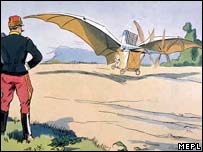As the official centennial celebrations for flight approach, there are those who challenge the claim of the Wright brothers, that they were the first to fly. Who are the claimants to this famous crown?

As the official centennial celebrations for flight approach, there are those who challenge the claim of the Wright brothers, that they were the first to fly. Who are the claimants to this famous crown?
It was the era of these wonderful men and their flying machines; A time when everything seemed possible when every pioneering invention became a victory.
The diesel engine, the pneumatic tire (which operates on air pressure), the radio, the escalator, the neon lights - all the things we take for granted today - appeared when the twilight of the 19th century gave way to a new dawn.
The highlight of the achievements was the accident on December 17, 1903 in North Carolina, this is the first flight in a motorized, controllable and heavier than air aircraft, carried out by Orville Wilbur Wright.
But were the Wright brothers really the first? Over the years, many have challenged their primacy.
Richard Pierce
One of the most determined campaigns to unseat the Wright brothers was led by supporters of Richard Pearce of New Zealand. It is said that Pierce was nine months ahead of the Wright brothers, so the first flight took place on March 31, 1903 (some say 1902).
An amateur farmer and inventor - his first invention, which was registered as a patent in 1902, was a bicycle made of hemlock wood - Pierce himself claimed in letters to local newspapers that he could not fly right before the Wright brothers.
Nevertheless, since his death, a campaign has been conducted in the South Island of New Zealand to rewrite the pages of history and recognize him as the first person to achieve powered flight.
Aeronautical historian Philip Jarrett calls these claims "grossly misleading." "This is the story of the local hero. They choose to ignore the factual statements of their hero himself,” says Mr Jarrett.
Pierce's plane, on the other hand, is more reliable: a single-wing (- monoplane as opposed to a biplane) plane with a steerable nose, it is a more similar ancestor to the modern plane than the Wright brothers' plane.
Clement Adar
A self-taught engineer and passionate about aviation, in 1890 Eder unveiled a steam-powered airplane with bat-like wings, called the Eole, but the Frenchman's legacy was tarnished by his later claims that he had defeated the Wright brothers.
In October of that year, he flew the plane 50 meters, in what was described more as "monitoring" than flight. It failed to meet the standards of sustained powered flight. Later, Eder claimed that he was the first to achieve motorized flight with the help of his "Avion 3" in 1897.
However, after a French military report was declassified, it became clear that the flight ended in failure. "Eder was a PR guy," says Mr Jarrett. "He had no complaints before the Wright brothers. He was grumpy and angry without a doubt."
A German immigrant to America, Gustav Whitehead claimed that he made motorized flights as early as 1898, initially with a steam-powered airplane and then with a fuel-powered aircraft that looked like a bathtub with fan-like wings. While apparently there were many eyewitness accounts, these flights were never officially confirmed. But the allegations arose again in 1935, eight years after Whitehead's death.
An article in a popular aviation journal presented eyewitness accounts of flights in 1898, 1901 and 1902. Experts claim that the story is not reliable. Some attribute it to the "hoax journalism" trend of those days, while others believe that the story was perpetuated by Albert Zem, the sworn enemy of the Wright brothers, who was in a patent fight with them.
Preston Watson
The "original" flying Scotsman, Preston Watson, like Richard Pearce, did not claim to be first in the sky. Instead, a fan club has banded together to demand the late Scot's name.
His flight is said to have taken place in the summer of 1903, when the twenty-three-year-old Watson launched an airplane while inside it with a catapult attached to two pulleys. The plane was powered by a tractor-type propeller.
As with many examples at the time, there is no verifiable evidence of the veracity of Watson's flight, other than vague eyewitness accounts. Watson died in the First World War.
Rabbi Barrel Canon
Rabbi Barrel's inspiration to fly up into the sky was drawn from the book of Ezekiel from the Bible, after which Rabbi's first airplane was named. Ezekiel's vision of lifting living creatures up off the ground with the help of wheels particularly fascinated him.
In 1900, the Texan founded a company to pursue his dream and raised $20,000. The result of this was an aircraft with fabric-covered wings and an engine, driving four sets of propellers.
It was said that it was a "fast flight" in 1902, but disaster intervened in the actions of Rav, who was on his way to the World's Fair in Set. Louis, where a prize of $100,000 awaited him for the first flight. A storm blew the plane off a freight trailer and smashed it into pieces.
